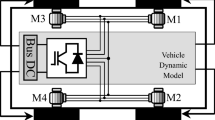Abstract
The electric vehicle with four direct-driven in-wheel motors is an over actuated system. A three-level control strategy of electronic stability control (ESC) is proposed to achieve optimal torque distribution for four in-wheel motors. The first level is a gain-scheduled linear quadratic regulator which is designed to generate the desired yaw moment command for ESC. Control allocation is the second level which is used to distribute the desired longitudinal tire forces according to the yaw moment command while satisfying the driver’s intent for acceleration and deceleration. The associated weighting matrix is designed using the work load ratio at each wheel to prevent saturating the tire. The third level is slip ratio control (SRC) which is employed at each wheel to generate the desired longitudinal tire force based on a combined-slip tire model. Simulation results show that the proposed method can enhance the ESC performance for the test maneuvers. Since the tire model is often unknown for practical implementation, the effectiveness of the SRC is studied using the sine with dwell test. It is found that the SRC is not crucial for achieving performance similar to the proposed method with SRC, if the slip ratio can be maintained in the stable region using traction control system/anti-lock braking system.
Similar content being viewed by others
References
Ando, N. and Fujimoto, H. (2010). Yaw-rate control for electric vehicle with active front/rear steering and driving/braking force distribution of rear wheels. Proc. 11th IEEE Int. Workshop on Advanced Motion Control, Nagaoka, Japan, 726–731.
Chen, B.-C. and Hsieh, F.-C. (2008). Sideslip angle estimation using extended Kalman filter. Vehicle System Dynamics 46, 1, 353–364.
Chu, Y.-T. (2012). Research and Development of Anti-lock Brake System using Road Condition Estimation. M.S. Thesis. National Taipei University of Technology. Taiwan.
Goodarzi, A. and Esmailzadeh, E. (2007). Design of a VDC system for all-wheel independent drive vehicles. IEEE/ASME Trans. Mechatronics 12, 6, 632–639.
Harkegard, O. and Glad, S. T. (2005). Resolving actuator redundancy — Optimal control vs. control allocation. Automatica, 41, 137–144.
Hattori Y., Koibuchi, K. and Yokoyama, T. (2002). Forceand moment control with nonlinear optimum distribution for vehicle dynamics. Proc. 6th Int. Advanced Vehicle Control.
He, P. and Hori, Y. (2007). Experimental evaluation of dynamic force distribution method for EV motion control. Proc. Power Conversion Conf., Nagoya, Japan, 682–687.
Mokhiamar, O. and Abe, M. (2004). Simultaneous optimal distribution of lateral and longitudinal tire forces for the model following control. J. Dynamic Systems, Measurement, and Control, 126, 753–763.
Mokhiamar, O. and Abe, M. (2006). How the four wheels should share forces in an optimum cooperative chassis control. Control Engineering Practice, 14, 295–304.
NHTSA (2006). Proposed FMVSS No. 126 Electronic Stability Control Systems. U.S. Department of Transportation.
Ono E., Hattori Y., Muragishi, Y. and Koibuchi, K. (2006). Vehicle dynamics integrated control for fourwheel-distributed steering and four-wheel-distributed traction/braking systems. Vehicle System Dynamics 44, 2, 139–151.
Pacejka, H. B. (2005). Tire and Vehicle Dynamics. 2nd edn. SAE. USA.
Pacejka, H. B. and Sharp, R. S. (1991). Shear force development by pneumatic tyres in steady state conditions: A review of modelling aspects. Vehicle System Dynamics 20, 3/4, 121–175.
Sakai, S. I. and Hori, Y. (1998). Robustified model matching control for motion control of electric vehicle. Proc. Int. Workshop on Advanced Motion Control, Coimbra, Portugal, 574–579.
Song, C. K., Uchanski, M. and Hedrick, J. K. (2002). Vehicle speed estimation using accelerometer and wheel speed measurements. SAE Paper No. 2002-01-2229.
Tseng, H. E., Ashrafi B., Madau D., Allen Brown, T. and Recker, D. (1999). The development of vehicle stability control at Ford. IEEE/ASME Trans. Mechatronics 4, 3, 223–234.
Xiong, L. and Yu, Z. (2009). Control allocation of vehicle dynamics control for a 4 in-wheel-motored EV. Proc. 2nd Int. Conf. Power Electronics and Intelligent Transportation System, Shenzhen, China, 307–311.
Yim, S., Cho, W., Yoon, J. and Yi, K. (2010). Optimum distribution of yaw moment for unified chassis control with limitation on the active front steering angle. Int. J. Automotive Technology 11, 5, 665–672.
Author information
Authors and Affiliations
Corresponding author
Rights and permissions
About this article
Cite this article
Chen, BC., Kuo, CC. Electronic stability control for electric vehicle with four in-wheel motors. Int.J Automot. Technol. 15, 573–580 (2014). https://doi.org/10.1007/s12239-014-0060-4
Received:
Revised:
Accepted:
Published:
Issue Date:
DOI: https://doi.org/10.1007/s12239-014-0060-4




